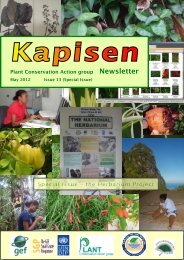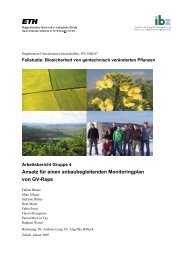Kapisen - ETH Zürich
Kapisen - ETH Zürich
Kapisen - ETH Zürich
Create successful ePaper yourself
Turn your PDF publications into a flip-book with our unique Google optimized e-Paper software.
Going one step further in saving<br />
the rare plants of Seychelles<br />
By James MOUGAL<br />
Botanical Gardens Section (MENR)<br />
j.mougal@env.gov.sc<br />
S a v i n g R a r e P l a n t s<br />
From the nursery to the field<br />
The success story of the Barbarons Biodiversity<br />
Centre (see <strong>Kapisen</strong> 1(2), p. 13) in partnership<br />
with Eden Project (UK) is remarkable. Many of<br />
the Seychelles endemic plants are now growing<br />
successfully in the nurseries of both places. A triumph<br />
has been that of the critically endangered Impatiens<br />
gordonii (Belzamin sovaz) (see <strong>Kapisen</strong> 1(2): p. 6-<br />
7). More than 100 plants have been multiplied at the<br />
Biodiversity Centre from cuttings collected from the<br />
two remaining populations (Anse Moudon, Silhouette<br />
/ Trois Fréres, Mahé).<br />
The next step after ex situ reproduction of rare<br />
plants is the reintroduction or reinforcement of these<br />
plants in their natural habitat, in line with the goal<br />
addressed in the Seychelles National Strategy for<br />
Plant Conservation to “ensure viable representation<br />
of 95% of threatened flowering plant taxa within<br />
protected areas” (Target 4b).<br />
I discuss in this article two on-going field monitoring<br />
projects of the Botanic Gardens Section (MENR).<br />
The monitoring of the remaining populations in the<br />
field is the basis of a successful reintroduction.<br />
Then, I present a recently funded project for the<br />
reintroduction of Belzamin sovaz and two more rare<br />
endemic plants.<br />
Field monitoring of Belzamin sovaz<br />
The question that keeps popping up is whether<br />
Belzamin sovaz will survive the transplantation<br />
back to places where it is still under threat or has<br />
completely disappeared. During field searches<br />
carried out in 2001 together with Alistair Griffiths,<br />
out of five populations known from the literature only<br />
two were found. The only population on Mahé was<br />
at Trois Fréres, approx. 600 m above sea level (Fig.<br />
1). It consisted of two groups – 14 plants in total.<br />
The first group of 12 plants was heavily attacked by<br />
caterpillars of the possibly native Common Striped<br />
Hawkmoth (Hippotion eson) (Fig. 2). Four individual<br />
plants were small and probably young seedlings (20-<br />
25 cm in height). Four of the larger individuals (40-<br />
100 cm in height) were flowering. The second group<br />
consisted of two individuals (80 and 108 cm) with the<br />
larger one bearing flowers and fruits.<br />
We re-surveyed the population at Trois Fréres in<br />
March 2004. Three groups of plants were located –<br />
approximately 20-22 plants in total. The largest group<br />
of c. 10-12 plants, with an average height of 90 cm,<br />
was not recorded in 2001 (covered area: 1.9 m by<br />
1.6 m). The smaller of the previously located groups<br />
increased from two to three individuals. The larger<br />
group decreased its size from 12 to 7. However,<br />
because among the located plants there were 2 new<br />
Fig. 1 James Mougal with one plant of the only Belzamin sovaz population on Mahé (W Mangroo).<br />
K a p i s e n 4 I s s u e 3







